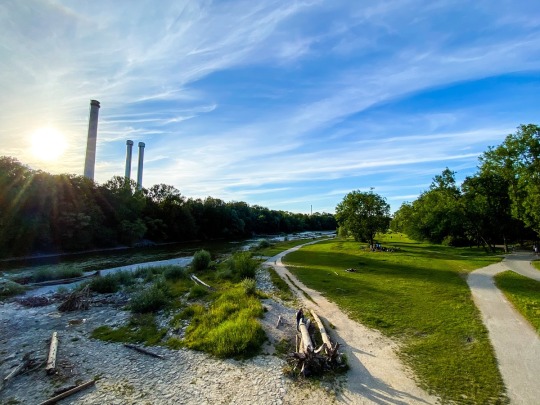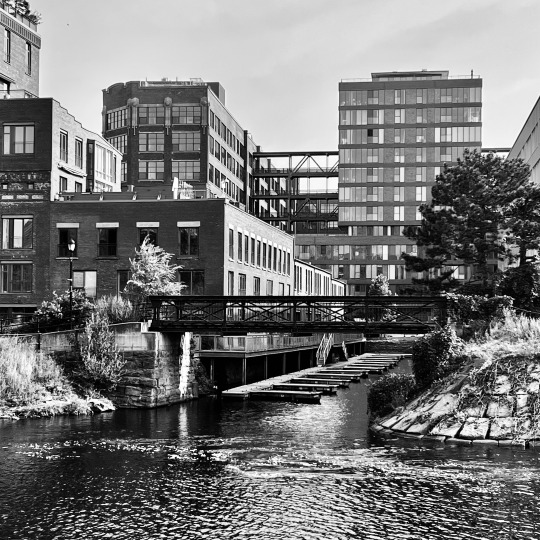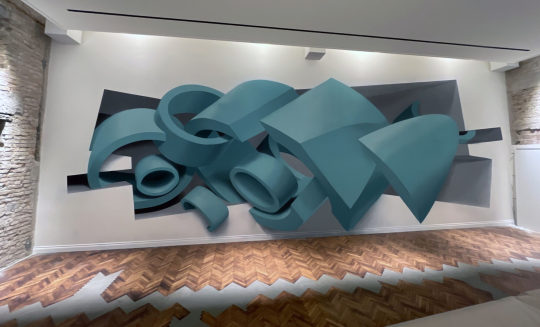#urban redevelopment
Explore tagged Tumblr posts
Text

A poster promoting planned housing as a solution to poor living conditions in cities, ca. 1936-1938.
Photo: Everett Collection
#vintage New York#1930s#vintage poster#urban planning#urban redevelopment#urban renewal#slums#tenements#1930s New York
33 notes
·
View notes
Text

Revitalizing the ocean economy with transformative sustainability innovation in urban planning and architectural design
Image: © Haptic Architects, Oslo Works, and BOGL
A waterside scheme spanning 45,000 sqm with features including Fjordarium—an aquarium with underwater galleries capturing the fjord’s marine life and anticipating its future. The facility is part of a wider knowledge hub of workspaces for marine industry and ocean tech businesses. Haptic Architects and Oslo Works reimagine a disused parking lot as a global centre for sustainable oceanic practices.

Fjordarium featuring underwater galleries that peek into the marine life of the fjord
The Fjord area is designed as the educational centre of the scheme and will house the Fjordarium. This building will provide an immersive visitor experience by offering a window directly into the fjord. The Fjordarium will encompass various facilities such as a restaurant, bar, gallery, event space, research laboratories, workspaces, and teaching rooms above and below the water level.

In collaboration with the Norwegian Institute for Water Research (NIVA), the design of the Fjordarium building has been created to safeguard marine biodiversity. The building, as per the design statement, will be engineered to withstand the fjord's waves and currents while maximising natural light penetration into the underwater areas. It will address the challenges and provide solutions for cleaning the heavily polluted fjord caused by agricultural waste. In partnership with We Are Human, the architects have conceived the Fjordarium as a destination that will seamlessly blend physical and virtual experiences. It will serve as a global learning platform, exploring the drivers of the new blue economy while promoting a shift towards environmental sustainability and a regenerative approach to oceans.
16 notes
·
View notes
Text

The Salt Box and The Castle on Bunker Hill, Los Angeles, 1968, by Wiliam Reagh
#bunker hill los angeles#urban redevelopment#los angeles#los angeles history#history#victorian architecture#victorian houses#william reagh#union bank plaza
5 notes
·
View notes
Text
Exploring Granville Island; a Vancouver Tourist Destination
May 29, 2025 Granville Island is a vibrant thirty-five-acre urban district located under the Burrard Bridge in Vancouver. Due to limited parking, we chose to take an Uber to get there. Granville Island is the most visited tourist destination in Canada after Niagara Falls, attracting over ten million visitors each year. The sandbar that is now Granville Island was a traditional fishing site for…

View On WordPress
#arts#British Columbia#canada#food#Granville Island#Jane Jacobs#markets#travel#urban redevelopment#vancouver
0 notes
Text
Re:Thinking the Urban: UEI Workshop Report
The Isarauen (Courtesy of Jan Antonin Kolar via Unsplash) By Daniel Dumas and Carolin Maertens 22 January 2021 The Urban Environments Initiative (UEI) held its third workshop entitled Re:Thinking the Urban on 22 January 2021. The online workshop brought UEI members from across the globe together for an in-depth analysis and discussion regarding two case studies of “spaces of living in…

View On WordPress
#interdisciplinarity#munich#renaturalization#schlachthof#the Isar#Urban Environments Initiative#urban planning#urban redevelopment
0 notes
Text
Huh! There was a post going around that outlined how this isn't especially feasible and suggested hydropenics as a more efficient alternative, but it seems this place has made it work for now! The luxurious vibes, I think, are due to the age of this building, as plain boring structures were much rarer in olden times. Just look at that railing! A colorado mall could never.
My concern is that the people who live there may not get outside enough - with so many necessary amenities 'indoors' it makes going outdoors more of a Special Activity. If exercise is anything to go by, things that are Necessary For Healthy Functioning are very taxing when they aren't already a natural part of your lifestyle. Making going properly outside into a Deliberate Activity will create friction, I think.
My local mall is doing Fine. But there's new closures frequently, even our kohl's went the way of sears just last year. I wonder what it would take to get the building manager on board with a plan like this. I hate seeing these enourmous spaces be abandoned. Maybe turn some of the parking lot into a nature garden and a plaza too, while we're at it. Wouldn't that be delightful?
youtube
I've heard people throwing the idea of converting the upper level of malls into apartments, but I guess I didn't realize how gorgeous that would actually look This seems as walkable as a university but like 10x as luxurious
#malls#dying mall#shopping mall#urban redevelopment#walkable cities#just ditch all the cameras first and don't implement any other high-tec privacy violations#that post was about the homeless specifically but housing for anyone helps too
8 notes
·
View notes
Text

Main street Skokie - waiting for redevelopment
#photography#ricohgr3#places#USA#illinois#skokie#urban#stripmall#urbanex#urbandecay#abandonedbuilding#redevelopment#construction#revitalization#storefront#streetphotography#quietstreets#laundromat#economic downturn#emptystreet#forgottenplaces#elloon
12 notes
·
View notes
Text
imagined what a mapping programme would be like on coruscant with all those levels and got disturbed by the man-made-horror-beyond-comprehension of it again.
okay that's a lie.
i imagined how geographical profiling would work on coruscant because i was thinking about how maul-tracking by 'this spot has especially rancid dark side vibes' could work since jedi can feel he's close by/following them/stalking (seems like someone didn't feel like teaching the sith hiding meditation to this particular apprentice) and then realized it would be a nightmare because regular geographical profiling only works in two dimensions, but all the levels of coruscant would mean you'd need more than 3 points to start with. possibly more than four. probably no less than six to get an accurate idea of how many levels are being covered. then got disturbed by the man-made-horror-beyond-comprehension of it again.
#keeping up with the skywalkers#now i have to invent a city-mapping - excuse me an 'urban compass' programme#just. black spots on it when you get down far enough that the areas were slated for redevelopment & only got demolished#and they keep growing as the level numbers get lower and lower#yeah the spot-on locator exists but i don't think it lets u set up your own locations#so CoruScope or something like that it shall be#also i'm renaming the 'quey'tek' meditation because /e/ doesn't exist in tsis. it should at least be qûjây'tâk or something similar.
3 notes
·
View notes
Text





Napa Valley Dreams
If you are interested, there is also a video!!
youtube
Now let's move inside this large home and take a look at the main floor. Unfortunately, within two weeks of my visit, this house was severely vandalised but there were still a lot of great things to be seen!!
#abandoned#urbex#urban exploring#urban exploration#bandos#abandoned buildings#abandoned places#forgotten#forgotten buildings#forgotten places#abandoned house#abandoned home#abandoned homes#abandoned houses#redevelopment#development#Youtube
5 notes
·
View notes
Text

Gentrification, Canal Lachine, Montréal, 2023.
Once lined with flour mills, grain storage facilities and other industrial uses, the land along the canal is now being developed with lofts and condos.
#urban landscape#redevelopment#gentrification#industry#canal lachine#montréal#québec#canada#2023#photographers on tumblr#black and white
12 notes
·
View notes
Text

The saga of San Juan Hill, cont'd (for Part I, see this post)
On September 11, 1957, residents of San Juan Hill, the integrated, predominantly working-class neighborhood on the West Side between 59th and 65th Streets and West End and Amsterdam Avenues, showed up at City Hall. They were protesting the destruction of their homes for the purpose of building an arts complex called Lincoln Center.
The public hearing lasted nearly 11 hours, with 24 speakers supporting the project and 36 opposed. The issue was framed as housing vs. culture. They also pointed out that the housing units that Robert Moses had reluctantly agreed to build as part of the redevelopment would be out of the price range of current residents.
Two weeks later, West Side Story opened on Broadway. It took place entirely in San Juan Hill, although the community was never referred to by name. Although it's hard to believe now, the show received generally cool reviews; critics were taken aback by its grim realism and aggressive, jazzy score (by Leonard Bernstein).
Many neighborhood residents were offended by the portrayal of their home. Puerto Ricans, who made up 24% of the population who lived there, objected particularly to the line in the show-stopping number "America" that called Puerto Rico an "island of tropical diseases." (They ignored the context, which is a back-and-forth between a Puerto Rican girl who romanticizes the island and another who mocks her dreamy outlook.)
On October 25, the Board of Estimate, which was then the city's main decision-making body, held another hearing on the redevelopment project. This one lasted 18 hours, but it seemed that the Board's minds were made up. In late November, they voted unanimously to go ahead with Lincoln Center. Next June, the first residents of San Juan Hill were relocated.
In 1960, as the last of the brownstones were being demolished, a film crew moved in. It was the (first) screen version of West Side Story.
youtube
Photo: Gothamist
#vintage New York#1950s#San Juan Hill#Lincoln Center#gentrification#urban renewal#West Side Story#redevelopment#communities#slum clearance#neighborhood destruction#public hearing#Upper West Side#Youtube#September 11#Sept. 11#11 Sept.
50 notes
·
View notes
Note
labour party issues a rehousing directive. you have to move to either telford or scunthorpe. you cannot kill yourself.
fucking hell. I'll hope that I can be rehoused in a nicely refurbished freehold '30s build in a nicer part of Telford then...
#i joke about telford but it's not *the* worst place in England#it's just. A Place. a 50s attempt at urban planning without a proper plan that mushed together a bunch of pre-existing towns and villages#they went ahead with development without even agreeing on how the town centre would look or even be!#that's why the whole place feels so disjointed!#that being said Ironbridge was in dire need of redevelopment beforehand apparently and people did get post-war rehousing#so there was an upside#rainydayscore
3 notes
·
View notes
Photo

The redevelopment art project Urban Colors has chosen as the location for its latest intervention Trieste, a city historically a meeting place for cultures from all over the Mediterranean and the scene of important events in the history of Italy.
The space chosen by Urban Colors is precisely a building that tells a page in the history of the 20th century, particularly that of the fascist regime. Luca Mayr, curator and artistic director of Urban Colors, and Ron Miller, art director of the project, chose to involve 16 artists to give a new face to the former Bank of Naples, now converted into a gymnasium.
The artists who collaborated on the project are some of the most recognized names in national and international street art such as Peeta, Ravo, Joys, Ozmo, Rancy, Oger, Amina, Sorte, Stuer, Corvino, Fosk, Stefano and Mattia Bonora, Samuele Frosio, Ron Miller, and Andrea639.




#redevelopment art project#urban colors#trieste#italy#culture#mediterranean#luca mayr#curator#artistic director#ron miller#art director#bank of naples#national street art#international street art
2 notes
·
View notes
Text
Denver Skyscraper Meltdown (Office Towers Collapse into 98% Discount Foreclosure Freefall)

Key Takeaways Over 30% of Denver’s office-building mortgages are delinquent, making it one of the worst-hit metro areas for commercial loan defaults in the U.S. Iconic downtown skyscrapers are selling at up to 98% discounts, signaling historic opportunities—and risks—for investors. Office-to-residential conversions are accelerating, offering long-term buy-and-hold investment potential with tax advantages and strategic entry points. Denver’s skyline is disintegrating under the weight of debt, vacancy, and foreclosure. What happens when billion-dollar buildings can’t even fetch scrap value? Is Denver about to become a real estate investor’s biggest comeback story, or the next Detroit? Historic collapse of Denver’s commercial office market Shocking discounts and foreclosures sweeping the city Investor opportunities in conversions, cash deals, and bulk buys Let’s tear into the chaos and see where savvy investors can strike gold in the rubble. The Implosion No One Saw Coming (But Should Have) Downtown Denver is crumbling—tower by tower, loan by loan. What was once a gleaming symbol of the Rocky Mountain economic boom has turned into a battlefield of delinquent debt and desperate sales. Nearly 30% of office-tied commercial mortgages across the metro are now delinquent, making Denver the third-worst performing office market in the nation, trailing only behind San Francisco and Houston. But this isn’t just a temporary slump—it’s a full-scale unraveling. The dominoes are falling faster than ever. From the iconic Wells Fargo Center, immortalized in the Denver Nuggets skyline, to Republic Plaza, the city’s tallest building, lenders are no longer waiting for a rebound. They’re seizing properties, appointing receivers, and forcing distressed owners to abandon ship. It’s not just vacancy—it’s value vaporization. Towers that fetched hundreds of millions just a few years ago are now barely worth a few million dollars. Investor sentiment has shifted from patient optimism to cold surrender. “We have a lot of 1980s high-rise towers that are mostly vacant,” admitted Amy Aldridge of Tributary Real Estate. “People want to come back to the office, but they don’t want to come back to the 1980s office.” The death of Denver’s outdated office stock has begun. For real estate investors, this isn’t just another cycle—it’s a once-in-a-generation shockwave of wealth transfer. But with blood in the water, will they survive the chaos or capitalize on the carnage? Let’s go deeper. Discounted to Death: Skyscrapers for Pennies on the Dollar Downtown Denver’s towers aren’t just distressed—they’re being fire-sold for prices that would make 2008 blush. In a surreal twist that feels more like a liquidation auction than a metropolitan investment market, massive office complexes once valued in the hundreds of millions are selling for less than 2% of their former worth. These aren’t fringe properties on the city’s edge—these are skyscrapers in the heart of downtown. Case in point: Colorado Plaza Tower I and Tower II, with a combined footprint of 1.14 million square feet, were purchased for just $3.2 million. That’s a shocking 98% discount from their $200 million valuation in 2019. For perspective, that’s $3.30 per square foot in a market where office rents average $41.87 per square foot. Other bloodletting sales include: Hudson’s Bay Centre: Sold for $8.95 million, down from $41.5 million in 2014, an 80% haircut. Lincoln Crossing: Dumped for $10 million, a 90% drop from the 2018 price. Wells Fargo Center: In receivership after defaulting on a $327 million loan. And it’s not just the price tags that are plummeting, equity is being wiped out, leaving owners with nothing but the debt they can’t repay. Even buildings still technically in the black are under quiet distress, with modified loan terms, silent defaults, and lenders playing the “extend and pretend” game just to delay the inevitable. Here’s how the financial carnage looks:
Building Previous Value Sale Price % Discount Status Colorado Plaza Towers I & II $200M $3.2M 98% Sold (conversion planned) Hudson’s Bay Centre $41.5M $8.95M 78% Sold (distressed) Lincoln Crossing $100M+ $10M 90% Sold (distressed) Wells Fargo Center $327M debt N/A N/A In receivership For veteran investors, these prices are either a siren song or a death knell. Are these skyscrapers bargains, or ticking financial time bombs? One thing is clear: the scale of these discounts is more than historic, it’s a once-in-a-century signal that Denver’s commercial core has collapsed in plain sight. And this is just the beginning. The biggest deals are still hiding in the shadows. Zombie Buildings and the “Receivership Shuffle” Denver’s downtown is crawling with zombie towers—soulless shells too broke to function and too expensive to fix. These once-prized properties now sit in purgatory, neither dead nor alive, as lenders scramble to recover what little value remains. At least a third of Denver’s 105 largest office buildings (each over 100,000 square feet) are in some form of extreme financial distress, including: Loan defaults Court-ordered receiverships Outright foreclosures Voluntary ownership surrenders Distressed sales at catastrophic discounts This isn’t just a market correction, it’s a massive asset wipeout happening in slow motion. The infamous Wells Fargo Center, also known as the “Cash Register Building,” is under receivership after Brookfield defaulted on a $327 million loan. Republic Plaza, Denver’s tallest building, narrowly avoided foreclosure by renegotiating $134 million in debt. Meanwhile, lenders are installing third-party managers to stabilize properties and prepare them for auction, repurposing, or demolition. The cycle of distress looks like this: Owner defaults on commercial loan Lender appoints receiver to take control of operations Vacancy soars, and income disappears Asset value plummets Fire sale or foreclosure follows Denver’s downtown core, particularly Upper Downtown, is the epicenter of this collapse. The zone from Lawrence to Lincoln Street and 14th to 20th Street is now known as the “Foreclosure Belt of the Rockies." These aren’t obscure properties. The walking wounded include: Civic Center Plaza (1560 Broadway): Ownership returned to lender Denver Energy Center (1625 & 1675 Broadway): Seized by JPMorgan Chase Trinity Place (1801 Broadway): Claimed at auction by LoanCore Capital 1670 Broadway: Under third-party management after October default 1999 Broadway: Facing potential 70% vacancy if IRS pulls out To make matters worse, federal agencies—once considered ironclad tenants—are fleeing. The Department of Government Efficiency is slashing leases, and the IRS is eyeing a mass exit, gutting an already fragile leasing environment. And just when landlords thought things couldn’t get worse, Elevance Health (formerly Anthem) dealt a deathblow to 700 Broadway, vacating over 258,000 square feet and taking a stable 4.7% vacancy rate to a staggering 60% overnight. Denver’s skyline isn’t just distressed—it’s actively decaying. Investors who don’t understand the “receivership shuffle” may step into a deal that drains them dry before delivering any return. The stakes are sky-high, and the vultures are circling. Investor Warzone or Goldmine? The Redevelopment Gamble Denver’s broken towers may be bleeding capital, but they’re not dead yet. For the bold, they might be the greatest real estate arbitrage opportunity of the decade. Amid this brutal downtown collapse, a quiet renaissance is being whispered behind the scenes: office-to-residential conversions. Developers and deep-pocketed investors are pouncing on the chaos, buying skyscrapers for pennies, then sinking tens of millions into massive renovations, hoping to resurrect them as upscale apartments or mixed-use hubs. The Colorado Plaza Towers I & II are ground zero for this strategy. Acquired for a jaw-dropping $3.
2 million, Los Angeles developer Asher Luzzatto plans to spend $150 million to $200 million transforming the vacant giants into 700+ residential units. It’s the ultimate distressed play: buy the shell for nothing, inject capital, and rebirth the building as a luxury cash-flow machine. But there’s a catch. These buildings weren’t designed for housing. Many were built in the 1950s to 1980s, with deep floor plates, obsolete mechanical systems, and layouts that don’t naturally fit apartments. Add in asbestos remediation, ground leases, and elevator retrofits, and the costs can explode before a single rent check rolls in. Still, the math could work—especially with the steep discounts. Consider: Current residential vacancy in desirable downtown districts remains far lower than office. Rents for upscale urban apartments in Denver continue to outperform aging commercial leases. City officials are actively incentivizing conversions with fast-track approvals and zoning flexibility. With property tax assessments based on residential rates, annual liabilities plummet compared to office use. Here’s the punchline: A healthy office tower generates 4x the property taxes of a residential one. If you bought it at a 98% discount? That tax savings becomes part of your margin. However, success isn’t guaranteed. These conversion plays require: Massive upfront capital Navigating permitting minefields Winning zoning variances Long holding periods before profitability This isn’t a quick flip. It’s a war of attrition, and only the best-capitalized, most patient players will survive. Still, if pulled off, the return on investment could be staggering. Turning Denver’s dead towers into residential gold may become the city’s most dramatic real estate comeback story ever. But only if the visionaries can outlast the chaos. Strategic Entry Points for RE Investors Right Now While institutional giants retreat, private investors have a rare window to seize Denver’s fractured skyline if they know where to strike. This is no time for hesitation. As traditional lenders pull back and national firms offload properties in desperation, nimble investors can wedge themselves into deals once thought untouchable. The barriers are down. The doors are open. The distressed Denver office market has become a target-rich environment for those who move fast. Here’s where savvy real estate investors are making their plays: Joint Ventures with Debt Holders: Private lenders and distressed debt funds are hunting for partners to help stabilize or reposition troubled assets. JV structures allow smaller investors to gain equity access without full capital exposure. Seller Financing Fire Sales: Owners teetering on default may finance a sale just to walk away clean, allowing investors to step in with minimal upfront cash, especially attractive for value-add specialists. Ground Lease Leverage: Some towers, like Colorado Plaza, are on ground leases. While often seen as a complication, these leases can be negotiated or extended, letting investors buy buildings cheap and defer full land costs. Syndicated Capital Raises: With 80%–90% discounts becoming the norm, syndicators are assembling capital quickly to scoop up buildings in bulk. This group investment model is drawing accredited investors eager for outsized upside in a high-risk market. Opportunity Zones & Federal Incentives: Certain sectors of downtown Denver fall within designated Opportunity Zones, creating tax deferral and elimination potential for long-term investors pursuing redevelopment. Watch Zones: Not all of Denver is collapsing. The sharpest divide is forming between zones: Market Zone Status Upper Downtown Collapse underway Skyline Park Corridor High distress, high upside Union Station District Stable and in demand Central Platte Valley Modern, partially leased Cherry Creek & RiNo Top-tier tenant migration Pro tip: Investors should avoid outdated Class B/C towers unless they come with either deep discounts or strong conversion potential.
Focus instead on buildings with structure, location, and zoning flexibility, even if partially distressed. In short, Denver’s downtown disaster is now a developer’s dream and an investor’s litmus test. The deals are there, but only for those who know where to look, how to negotiate, and when to pounce. This isn’t just about timing the market, it’s about timing the implosion. Caution Ahead: Why Not All Distressed Assets Are Hidden Treasures In Denver’s downtown bloodbath, not every fire sale is a fortune. Some deals are dressed-up disasters waiting to detonate your capital. Yes, the headlines are blaring about 98% discounts. But behind those numbers lie ticking time bombs: toxic financing, terminally outdated layouts, and mechanical systems older than the internet. If you think every distressed tower is a hidden gem, think again—some of these buildings are unsalvageable money pits. Before you sink a dollar into Denver’s downtown, consider the real risks lurking beneath the surface: Outdated Infrastructure: Many of the worst-hit towers were built in the 1950s–1980s. Think lead pipes, low ceilings, inefficient HVAC systems, and asbestos in the walls. Retrofits cost millions—sometimes more than the building itself. Unfavorable Ground Leases: Several properties sit on land the buyer doesn’t own. Ground leases can be expensive, expiring, or non-renegotiable, strangling future ROI and complicating financing options. Zombie Tenancy and Leasing Black Holes: Buildings advertising “only 30% vacancy” may have ghost tenants—businesses that exist on paper but haven’t paid rent in months. Or leases that expire within a year with no renewals in sight. Lender-Controlled Death Spirals: Many distressed towers are under special servicing, receivership, or foreclosure, which means navigating multiple parties, legal red tape, and uncertain timelines. You could spend months bidding on a property only for the lender to yank it off the market at the last minute. Use Restrictions and Zoning Limits: Denver may be open to residential conversions, but not every building qualifies. Zoning overlays, height restrictions, historic designations, and structural limitations can kill a conversion plan before it starts. Skyrocketing Conversion Costs: What starts as a $10M steal could end up a $75M headache. Between permitting delays, structural retrofits, union labor costs, and inflation, many redevelopment projects are blown off course before lease-up. Investors chasing the siren song of downtown Denver must learn to differentiate between value and vacancy. There’s a difference between buying low and buying doomed. This market demands due diligence like never before. That means: Walking every property Inspecting every mechanical system Confirming lease status and zoning classifications Modeling worst-case scenarios, not just pro forma dreams Because in Denver’s crumbling core, the greatest fortunes and the greatest failures will be built on the same broken towers. The difference? Who knew what they were really buying? The City’s Future—and Your Window of Opportunity Denver isn’t dying—it’s transforming. But the path forward will be brutal, political, and wildly profitable for the right investors. Behind the boarded-up doors and half-empty high-rises, a new Denver is already beginning to take shape. The city's leadership knows its commercial tax base is collapsing—and with it, the revenue that funds everything from schools to sidewalks. This fiscal squeeze is forcing policymakers to embrace redevelopment and incentivize conversions like never before. According to Denver County Assessor Keith Erffmeyer, the last two-year assessment cycle saw a 25% drop in downtown commercial property values. That number is expected to plunge even further now that deeply distressed sales, some at 90%+ discounts, have begun flooding the books. Here’s the financial fallout: Office-to-residential conversions slash tax revenue. Thanks to Colorado’s
lower residential assessment rate, a converted tower will generate only one-quarter the property taxes of a stabilized office building. Sales and employment taxes vanish. Empty buildings mean no workers, no coffee shop sales, no lunch rush, no dry cleaners, no retail. This ripple effect devastates nearby businesses and erodes Denver’s long-term economic base. Yet… there’s hope. The city has no choice but to rebuild, rezone, and reinvest. Here’s what that means for real estate investors: Zoning Flexibility Is Expanding. Denver planners are under pressure to loosen restrictions to make conversion projects pencil out. New Resident Influx = Long-Term Stability. Every successful tower-to-apartment flip brings hundreds of new residents downtown, fueling demand for retail, amenities, and services. Public-Private Partnerships Are on the Rise. Expect tax incentives, grants, and development subsidies to flow toward those willing to bet big on downtown. This isn’t just a real estate cycle, it’s a civic identity crisis. And it’s one that creative, well-capitalized investors can help solve. You’re not just buying a broken building, you’re buying a stake in Denver’s comeback. The future of Denver’s downtown will be decided not by the city’s bureaucrats, but by the builders, buyers, and visionaries who step in during the chaos. The window is narrow. The stakes are sky-high. And your opportunity is now. Assessment Denver’s downtown skyline is no longer a symbol of growth—it’s a flashing red warning light for cities across America. What we’re witnessing isn’t just a collapse in property values. It’s a violent rebalancing of urban priorities, investor expectations, and commercial real estate fundamentals. For real estate investors, this is a moment of brutal clarity: The rules have changed. The math has changed. But the opportunity has never been greater. Yes, the risks are real: obsolete infrastructure, tenant flight, political uncertainty, and razor-thin margins on conversions. But in every great collapse lies the seed of reinvention. Investors who understand that timing, creativity, and grit now outweigh square footage and prestige will be the ones to reshape Denver and profit from its rebirth. Whether you’re scouting bulk office buys at 10 cents on the dollar, assembling capital for adaptive reuse, or locking in land deals before the next upcycle hits, the battlefield is set. The question is no longer if Denver will recover. It’s who will own it when it does.
#buy and hold#capital injection#capital restructuring#CMBS defaults#Colorado#commercial collapse#debt distress#Denver#distressed assets#downtown investments#foreclosure crisis#government leases#market crash#market implosion#office towers#Receivership#redevelopment#skyscraper deals#tax revenue decline#tenant exodus#tower conversion#tower sales#undervalued properties#Upper Downtown#urban conversions#urban planning#vacancy rates
1 note
·
View note
Text
Norman Street Will Break Your Heart
Norman Street has been an important street in Salem for centuries, serving as an east-west way first to the harbor, then to the train station, and linking downtown and the city’s west-lying residential neighborhoods. It was once tree-lined, along with Georgian colonial houses interspersed with shops. It had a bit of a reputation as an American “Harley Street,” with several prominent physicians in…

View On WordPress
#Architecture#Archives#Historic Preservation#Phillips Library#Photography#Salem Redevelopment Authority#Salem State University Archives & Special Collections#urban planning
0 notes
Text
A New Era for Pimlico: Maryland Approves Bold Rebuild of Historic Racetrack
In a landmark decision that blends preservation with progress, Maryland has officially greenlit the demolition and reconstruction of the historic Pimlico Race Course, breathing new life into one of the oldest active racetracks in the United States. With this approval, Maryland is making a bold bet on the future—not only of horse racing, but of local economic development and the state’s enduring…
#Baltimore#community investment#construction projects#economic development#historic preservation#horse racing#job creation#Maryland#Maryland economy#Maryland politics#Park Heights#Pimlico Racetrack#Preakness Stakes#racetrack redevelopment#racing fans#racing industry#sports infrastructure#stadium authority#Triple Crown#urban revitalization
0 notes